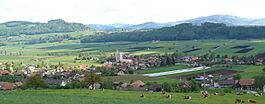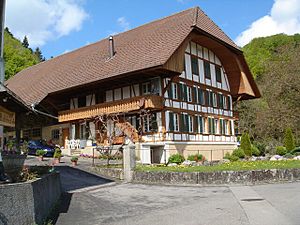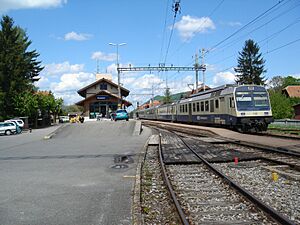Mühlethurnen facts for kids
Quick facts for kids
Mühlethurnen
|
||
|---|---|---|
 |
||
|
||
| Country | Switzerland | |
| Canton | Bern | |
| District | Bern-Mittelland | |
| Area | ||
| • Total | 2.9 km2 (1.1 sq mi) | |
| Elevation | 573 m (1,880 ft) | |
| Population
(Dec 2012)
|
||
| • Total | 1,372 | |
| • Density | 473/km2 (1,225/sq mi) | |
| Postal code |
3127
|
|
| Surrounded by | Kirchdorf, Kirchenthurnen, Lohnstorf, Mühledorf, Riggisberg | |
Mühlethurnen was a small town, also called a municipality, located in the Bern-Mittelland area in the canton of Bern, Switzerland. On January 1, 2020, Mühlethurnen joined with two other nearby towns, Kirchenthurnen and Lohnstorf. Together, they formed a new, larger municipality called Thurnen.
Contents
History of Mühlethurnen
Early Beginnings and Land Ownership
Mühlethurnen was first mentioned in the 1300s. Back then, a family called von Blankenburg owned land here. They also owned land in the nearby town of Kirchenthurnen. In 1343 and 1362, this family gave their lands and rights to Interlaken Monastery.
Changes with the Reformation
In 1528, the city of Bern adopted a new Christian faith called the Protestant Reformation. This meant they took over the monastery and all its lands. Mühlethurnen then became part of the Thurnen district and church area.
Growth and Development
From 1855 to 1911, projects were done to fix the Gürbe river. This helped drain the swampy valley, creating more land for farming. In 1901, a train station was built in Mühlethurnen, connecting it to the rest of Switzerland.
In the 1970s, more people started moving to Mühlethurnen. It became an important local center in the Gürbe valley. Today, people in Mühlethurnen work in farming, make sauerkraut, or run small businesses. Many residents travel to nearby cities for their jobs.
School History
Mühlethurnen opened its first village school in 1871. In 1912, the school moved to Riggisberg. Now, Mühlethurnen and Lohnstorf share a school district, and the main school is located in Mühlethurnen.
Exploring Mühlethurnen's Geography
Mühlethurnen covers an area of about 2.9 square kilometers (1.1 square miles). A large part of this area, about 72%, is used for farming. Forests cover about 7.5% of the land.
The rest of the municipality, about 19.5%, has buildings or roads. A small amount, less than 1%, is made up of rivers or lakes. Most of the forested land is covered with thick forests.
Land Use Details
- Housing and Buildings: About 11.3% of the land is used for homes and other buildings.
- Transportation: Roads and other transport areas make up 5.5%.
- Utilities: Power and water systems take up 1.4% of the area.
- Farming: Over half of the farming land (51.5%) is used for growing crops. About 19.1% is for pastures, and 1.4% is for fruit trees or vineyards.
Location and Features
Mühlethurnen is located in the Gürbetal (Gürbe valley), on the side of the Längenberg mountain. The municipality includes the main village of Mühlethurnen. It also has smaller settlements, called hamlets, like Mühlebach and Pontel-Freudberg, along with some scattered houses.
In 2010, Mühlethurnen joined the new Bern-Mittelland administrative district. This change helped organize how the local government worked.
Mühlethurnen's Coat of Arms
The blazon (description) of Mühlethurnen's coat of arms is: Red background with a silver tower with battlements and a silver half mill wheel at the bottom.
Both the half mill wheel (halben Mühlrad in German) and the tower (Turm in German) are examples of canting arms. This means the symbols on the coat of arms sound like parts of the town's name. "Mühle" sounds like "mill" and "Thurnen" sounds like "Turm" (tower).
People of Mühlethurnen (Demographics)
As of 2012, Mühlethurnen had a population of 1,372 people. About 4.3% of these residents were foreign nationals. The population changed by about 1% between 2010 and 2012. Most of this change came from births and deaths.
Languages Spoken
In 2000, most people in Mühlethurnen (96.7%) spoke German as their main language. French was the second most common language (0.8%), followed by English (0.3%).
Where People Come From
About 26.5% of the people living in Mühlethurnen in 2000 were born there. Over half (52.8%) were born in the same canton (Bern). About 11.2% were born elsewhere in Switzerland, and 5.7% were born outside of Switzerland.
Age Groups
In 2012, the population was divided into age groups:
- Children and Teenagers (0–19 years old): 20.6%
- Adults (20–64 years old): 60.9%
- Seniors (over 64 years old): 18.4%
Family Life
In 2000, there were 550 single people in Mühlethurnen who had never been married. There were 632 married people, 67 widows or widowers, and 41 divorced people.
Housing in Mühlethurnen
In 2010, there were 162 households with only one person. There were also 38 households with five or more people. In 2000, most apartments (94%) were lived in all the time. Only a small number were empty or used only part-time. In 2011, single-family homes made up 62.1% of all housing in the town.
Population Changes Over Time
The chart below shows how Mühlethurnen's population has changed through history:

Mühlethurnen's Economy and Jobs
In 2011, Mühlethurnen had a low unemployment rate of 1.63%. This means most people who wanted to work had jobs. There were 253 people working in the municipality.
Types of Jobs
Jobs are often grouped into three main types:
- Primary Sector: This includes jobs that get raw materials from nature, like farming. In Mühlethurnen, 28 people worked in this sector, mostly in agriculture.
- Secondary Sector: These jobs turn raw materials into products, like manufacturing or construction. There were 62 people working in this sector, with many in construction.
- Tertiary Sector: This includes jobs that provide services, like shops, transportation, or education. Mühlethurnen had 163 people working in this sector.
In 2008, there were 174 full-time equivalent jobs. Many jobs were in sales, transportation, hotels, insurance, education, and healthcare.
Commuting and Work Life
In 2000, 108 workers traveled into Mühlethurnen for their jobs. However, 529 workers traveled out of the town to work elsewhere. This means many people who live in Mühlethurnen work in other places. About 33.4% of working people used public transport, and 44.6% used a private car to get to work.
Financial Support
In 2011, a small number of people, about 1.8% of the population, received financial help from the government.
Religion in Mühlethurnen
Based on a 2000 survey, most people in Mühlethurnen (74.8%) belonged to the Swiss Reformed Church. About 7.7% were Roman Catholic.
A smaller number of people belonged to other Christian churches, or were Muslim, Buddhist, or Hindu. About 8% of the population said they did not belong to any church, or were agnostic (not sure about God) or atheist (do not believe in God).
Learning and Education
In Mühlethurnen, about 60.9% of adults have finished high school (called upper secondary education). About 21.3% have gone on to higher education, like a university or a special college (Fachhochschule).
The Swiss School System
The school system in the Canton of Bern works like this:
- Kindergarten: One year of optional (not required) kindergarten.
- Primary School: Six years of primary school.
- Lower Secondary School: Three years of required secondary school. Students are grouped based on their abilities.
- After lower secondary school, students can continue their education or start an apprenticeship (learning a job while working).
Local Schools in Mühlethurnen
During the 2011-2012 school year, 157 students attended schools in Mühlethurnen.
- There was one kindergarten class with 23 students.
- There were seven primary classes with 113 students.
- There were two lower secondary classes with 21 students.
In 2000, 141 students lived and went to school in Mühlethurnen. Another 29 students came from other towns to study there. Also, 81 students from Mühlethurnen went to schools outside the municipality.
See also
 In Spanish: Mühlethurnen para niños
In Spanish: Mühlethurnen para niños








